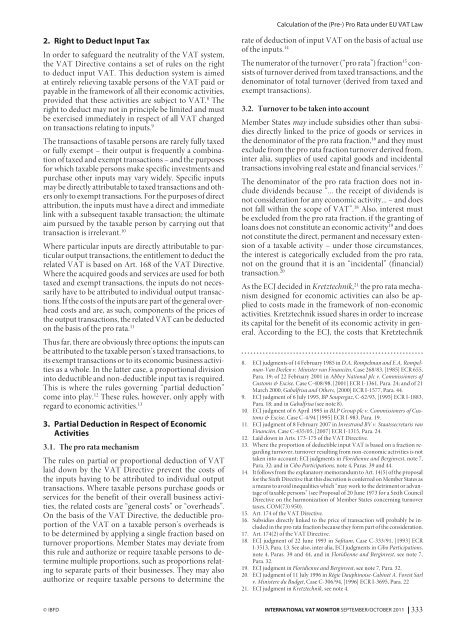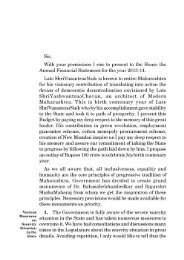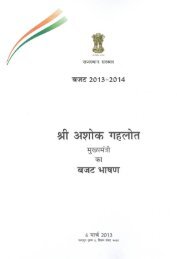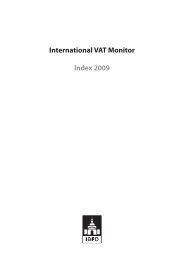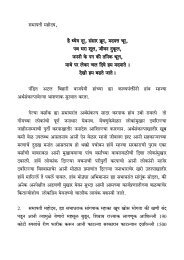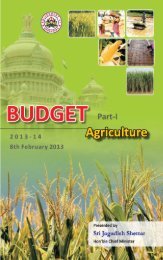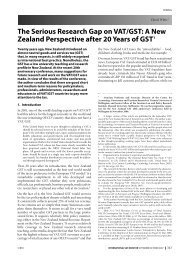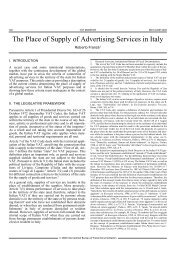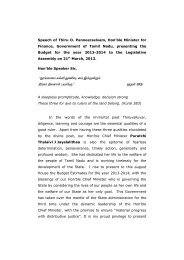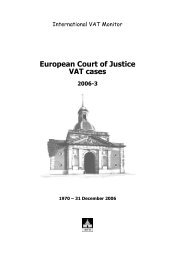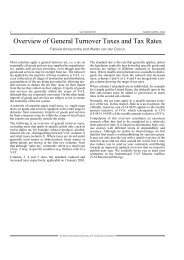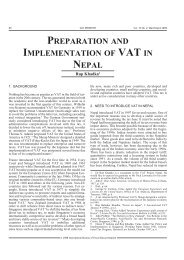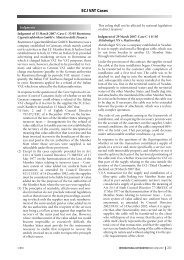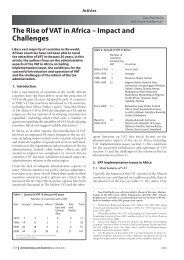Calculation of the (Pre-) Pro Rata under EU VAT Law - empcom.gov.in
Calculation of the (Pre-) Pro Rata under EU VAT Law - empcom.gov.in
Calculation of the (Pre-) Pro Rata under EU VAT Law - empcom.gov.in
You also want an ePaper? Increase the reach of your titles
YUMPU automatically turns print PDFs into web optimized ePapers that Google loves.
2. Right to Deduct Input Tax<br />
In order to safeguard <strong>the</strong> neutrality <strong>of</strong> <strong>the</strong> <strong>VAT</strong> system,<br />
<strong>the</strong> <strong>VAT</strong> Directive conta<strong>in</strong>s a set <strong>of</strong> rules on <strong>the</strong> right<br />
to deduct <strong>in</strong>put <strong>VAT</strong>. This deduction system is aimed<br />
at entirely reliev<strong>in</strong>g taxable persons <strong>of</strong> <strong>the</strong> <strong>VAT</strong> paid or<br />
payable <strong>in</strong> <strong>the</strong> framework <strong>of</strong> all <strong>the</strong>ir economic activities,<br />
provided that <strong>the</strong>se activities are subject to <strong>VAT</strong>. 8 The<br />
right to deduct may not <strong>in</strong> pr<strong>in</strong>ciple be limited and must<br />
be exercised immediately <strong>in</strong> respect <strong>of</strong> all <strong>VAT</strong> charged<br />
on transactions relat<strong>in</strong>g to <strong>in</strong>puts. 9<br />
The transactions <strong>of</strong> taxable persons are rarely fully taxed<br />
or fully exempt – <strong>the</strong>ir output is frequently a comb<strong>in</strong>ation<br />
<strong>of</strong> taxed and exempt transactions – and <strong>the</strong> purposes<br />
for which taxable persons make specific <strong>in</strong>vestments and<br />
purchase o<strong>the</strong>r <strong>in</strong>puts may vary widely. Specific <strong>in</strong>puts<br />
may be directly attributable to taxed transactions and o<strong>the</strong>rs<br />
only to exempt transactions. For <strong>the</strong> purposes <strong>of</strong> direct<br />
attribution, <strong>the</strong> <strong>in</strong>puts must have a direct and immediate<br />
l<strong>in</strong>k with a subsequent taxable transaction; <strong>the</strong> ultimate<br />
aim pursued by <strong>the</strong> taxable person by carry<strong>in</strong>g out that<br />
transaction is irrelevant. 10<br />
Where particular <strong>in</strong>puts are directly attributable to particular<br />
output transactions, <strong>the</strong> entitlement to deduct <strong>the</strong><br />
related <strong>VAT</strong> is based on Art. 168 <strong>of</strong> <strong>the</strong> <strong>VAT</strong> Directive.<br />
Where <strong>the</strong> acquired goods and services are used for both<br />
taxed and exempt transactions, <strong>the</strong> <strong>in</strong>puts do not necessarily<br />
have to be attributed to <strong>in</strong>dividual output transactions.<br />
If <strong>the</strong> costs <strong>of</strong> <strong>the</strong> <strong>in</strong>puts are part <strong>of</strong> <strong>the</strong> general overhead<br />
costs and are, as such, components <strong>of</strong> <strong>the</strong> prices <strong>of</strong><br />
<strong>the</strong> output transactions, <strong>the</strong> related <strong>VAT</strong> can be deducted<br />
on <strong>the</strong> basis <strong>of</strong> <strong>the</strong> pro rata. 11<br />
Thus far, <strong>the</strong>re are obviously three options: <strong>the</strong> <strong>in</strong>puts can<br />
be attributed to <strong>the</strong> taxable person’s taxed transactions, to<br />
its exempt transactions or to its economic bus<strong>in</strong>ess activities<br />
as a whole. In <strong>the</strong> latter case, a proportional division<br />
<strong>in</strong>to deductible and non-deductible <strong>in</strong>put tax is required.<br />
This is where <strong>the</strong> rules <strong>gov</strong>ern<strong>in</strong>g “partial deduction”<br />
come <strong>in</strong>to play. 12 These rules, however, only apply with<br />
regard to economic activities. 13<br />
3. Partial Deduction <strong>in</strong> Respect <strong>of</strong> Economic<br />
Activities<br />
3.1. The pro rata mechanism<br />
The rules on partial or proportional deduction <strong>of</strong> <strong>VAT</strong><br />
laid down by <strong>the</strong> <strong>VAT</strong> Directive prevent <strong>the</strong> costs <strong>of</strong><br />
<strong>the</strong> <strong>in</strong>puts hav<strong>in</strong>g to be attributed to <strong>in</strong>dividual output<br />
transactions. Where taxable persons purchase goods or<br />
services for <strong>the</strong> benefit <strong>of</strong> <strong>the</strong>ir overall bus<strong>in</strong>ess activities,<br />
<strong>the</strong> related costs are “general costs” or “overheads”.<br />
On <strong>the</strong> basis <strong>of</strong> <strong>the</strong> <strong>VAT</strong> Directive, <strong>the</strong> deductible proportion<br />
<strong>of</strong> <strong>the</strong> <strong>VAT</strong> on a taxable person’s overheads is<br />
to be determ<strong>in</strong>ed by apply<strong>in</strong>g a s<strong>in</strong>gle fraction based on<br />
turnover proportions. Member States may deviate from<br />
this rule and authorize or require taxable persons to determ<strong>in</strong>e<br />
multiple proportions, such as proportions relat<strong>in</strong>g<br />
to separate parts <strong>of</strong> <strong>the</strong>ir bus<strong>in</strong>esses. They may also<br />
authorize or require taxable persons to determ<strong>in</strong>e <strong>the</strong><br />
<strong>Calculation</strong> <strong>of</strong> <strong>the</strong> (<strong>Pre</strong>-) <strong>Pro</strong> <strong>Rata</strong> <strong>under</strong> <strong>EU</strong> <strong>VAT</strong> <strong>Law</strong><br />
rate <strong>of</strong> deduction <strong>of</strong> <strong>in</strong>put <strong>VAT</strong> on <strong>the</strong> basis <strong>of</strong> actual use<br />
<strong>of</strong> <strong>the</strong> <strong>in</strong>puts. 14<br />
The numerator <strong>of</strong> <strong>the</strong> turnover (“pro rata”) fraction15 consists<br />
<strong>of</strong> turnover derived from taxed transactions, and <strong>the</strong><br />
denom<strong>in</strong>ator <strong>of</strong> total turnover (derived from taxed and<br />
exempt transactions).<br />
3.2. Turnover to be taken <strong>in</strong>to account<br />
Member States may <strong>in</strong>clude subsidies o<strong>the</strong>r than subsidies<br />
directly l<strong>in</strong>ked to <strong>the</strong> price <strong>of</strong> goods or services <strong>in</strong><br />
<strong>the</strong> denom<strong>in</strong>ator <strong>of</strong> <strong>the</strong> pro rata fraction, 16 and <strong>the</strong>y must<br />
exclude from <strong>the</strong> pro rata fraction turnover derived from,<br />
<strong>in</strong>ter alia, supplies <strong>of</strong> used capital goods and <strong>in</strong>cidental<br />
transactions <strong>in</strong>volv<strong>in</strong>g real estate and f<strong>in</strong>ancial services. 17<br />
The denom<strong>in</strong>ator <strong>of</strong> <strong>the</strong> pro rata fraction does not <strong>in</strong>clude<br />
dividends because “... <strong>the</strong> receipt <strong>of</strong> dividends is<br />
not consideration for any economic activity... – and does<br />
not fall with<strong>in</strong> <strong>the</strong> scope <strong>of</strong> <strong>VAT</strong>”. 18 Also, <strong>in</strong>terest must<br />
be excluded from <strong>the</strong> pro rata fraction, if <strong>the</strong> grant<strong>in</strong>g <strong>of</strong><br />
loans does not constitute an economic activity19 and does<br />
not constitute <strong>the</strong> direct, permanent and necessary extension<br />
<strong>of</strong> a taxable activity – <strong>under</strong> those circumstances,<br />
<strong>the</strong> <strong>in</strong>terest is categorically excluded from <strong>the</strong> pro rata,<br />
not on <strong>the</strong> ground that it is an “<strong>in</strong>cidental” (f<strong>in</strong>ancial)<br />
transaction. 20<br />
As <strong>the</strong> ECJ decided <strong>in</strong> Kretztechnik, 21 <strong>the</strong> pro rata mechanism<br />
designed for economic activities can also be applied<br />
to costs made <strong>in</strong> <strong>the</strong> framework <strong>of</strong> non-economic<br />
activities. Kretztechnik issued shares <strong>in</strong> order to <strong>in</strong>crease<br />
its capital for <strong>the</strong> benefit <strong>of</strong> its economic activity <strong>in</strong> general.<br />
Accord<strong>in</strong>g to <strong>the</strong> ECJ, <strong>the</strong> costs that Kretztechnik<br />
8. ECJ judgments <strong>of</strong> 14 February 1985 <strong>in</strong> D.A. Rompelman and E.A. Rompelman-Van<br />
Deelen v. M<strong>in</strong>ister van F<strong>in</strong>anciën, Case 268/83, [1985] ECR 655,<br />
Para. 19; <strong>of</strong> 22 February 2001 <strong>in</strong> Abbey National plc v. Commissioners <strong>of</strong><br />
Customs & Excise, Case C-408/98, [2001] ECR I-1361, Para. 24; and <strong>of</strong> 21<br />
March 2000, Gabalfrisa and O<strong>the</strong>rs, [2000] ECR I-1577, Para. 44.<br />
9. ECJ judgment <strong>of</strong> 6 July 1995, BP Soupergaz, C-62/93, [1995] ECR I-1883,<br />
Para. 18; and <strong>in</strong> Gabalfrisa (see note 8).<br />
10. ECJ judgment <strong>of</strong> 6 April 1995 <strong>in</strong> BLP Group plc v. Commissioners <strong>of</strong> Customs<br />
& Excise, Case C-4/94 [1995] ECR I-983, Para. 19.<br />
11. ECJ judgment <strong>of</strong> 8 February 2007 <strong>in</strong> Investrand BV v. Staatssecretaris van<br />
F<strong>in</strong>anciën, Case C-435/05, [2007] ECR I-1315, Para. 24.<br />
12. Laid down <strong>in</strong> Arts. 173-175 <strong>of</strong> <strong>the</strong> <strong>VAT</strong> Directive.<br />
13. Where <strong>the</strong> proportion <strong>of</strong> deductible <strong>in</strong>put <strong>VAT</strong> is based on a fraction regard<strong>in</strong>g<br />
turnover, turnover result<strong>in</strong>g from non-economic activities is not<br />
taken <strong>in</strong>to account; ECJ judgments <strong>in</strong> Floridienne and Berg<strong>in</strong>vest, note 7,<br />
Para. 32; and <strong>in</strong> Cibo Participations, note 4, Paras. 39 and 44.<br />
14. It follows from <strong>the</strong> explanatory memorandum to Art. 14(5) <strong>of</strong> <strong>the</strong> proposal<br />
for <strong>the</strong> Sixth Directive that this discretion is conferred on Member States as<br />
a means to avoid <strong>in</strong>equalities which “may work to <strong>the</strong> detriment or advantage<br />
<strong>of</strong> taxable persons” (see <strong>Pro</strong>posal <strong>of</strong> 20 June 1973 for a Sixth Council<br />
Directive on <strong>the</strong> harmonization <strong>of</strong> Member States concern<strong>in</strong>g turnover<br />
taxes, COM(73) 950).<br />
15. Art. 174 <strong>of</strong> <strong>the</strong> <strong>VAT</strong> Directive.<br />
16. Subsidies directly l<strong>in</strong>ked to <strong>the</strong> price <strong>of</strong> transaction will probably be <strong>in</strong>cluded<br />
<strong>in</strong> <strong>the</strong> pro rata fraction because <strong>the</strong>y form part <strong>of</strong> <strong>the</strong> consideration.<br />
17. Art. 174(2) <strong>of</strong> <strong>the</strong> <strong>VAT</strong> Directive.<br />
18. ECJ judgment <strong>of</strong> 22 June 1993 <strong>in</strong> S<strong>of</strong>itam, Case C-333/91, [1993] ECR<br />
I-3513, Para. 13. See also, <strong>in</strong>ter alia, ECJ judgments <strong>in</strong> Cibo Participations,<br />
note 4, Paras. 39 and 44, and <strong>in</strong> Floridienne and Berg<strong>in</strong>vest, see note 7,<br />
Para. 32.<br />
19. ECJ judgment <strong>in</strong> Floridienne and Berg<strong>in</strong>vest, see note 7, Para. 32,<br />
20. ECJ judgment <strong>of</strong> 11 July 1996 <strong>in</strong> Régie Dauph<strong>in</strong>oise-Cab<strong>in</strong>et A. Forest Sarl<br />
v. M<strong>in</strong>istere du Budget, Case C-306/94, [1996] ECR I-3695, Para. 22<br />
21. ECJ judgment <strong>in</strong> Kretztechnik, see note 4.<br />
© IBFD INTERNATIONAL <strong>VAT</strong> MONITOR SEPTEMBER/OCTOBER 2011<br />
333


